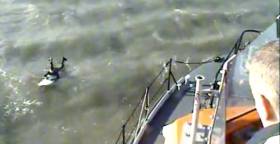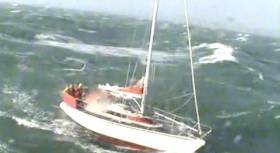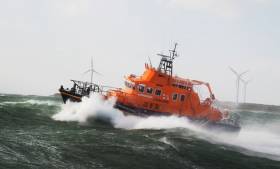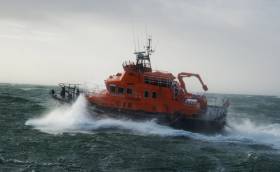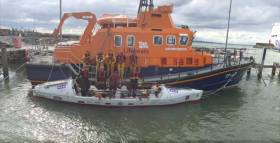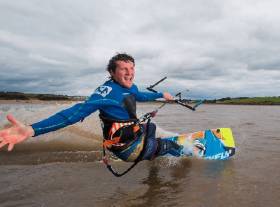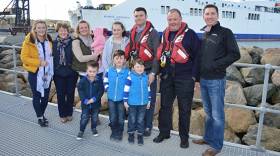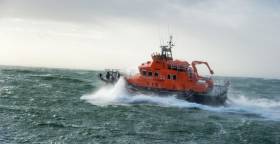Displaying items by tag: Rosslare
Surfer Caught in Rip Current Rescued by Rosslare Harbour RNLI off Wexford Coast (VIDEO)
Rosslare Harbour RNLI all-weather lifeboat was launched this afternoon (1 January) at 1.15pm to go to the assistance of a surfer caught in a dangerous rip current.
Two surfers had got caught in the rip current off Curracloe beach in Wexford. One of the surfers managed to get back to the beach where she quickly raised the alarm. With a strong south westerly force six to seven wind, the stranded surfer was soon a mile off shore.
Launched in minutes, the Rosslare Harbour lifeboat was joined on scene by Rescue 117, who located the lone surfer from the air and directed the lifeboat crew to the young man.
RNLI volunteer crew lifted the surfer to safety on board the lifeboat and provided warm and dry clothing for him on the return to the lifeboat station. He was met there by ambulance personnel who provided additional care.
Speaking after the incident Rosslare Harbour RNLI Volunteer Lifeboat Press Officer Jamie Ryan said, ‘It is wonderful to start the year with a successful rescue and thanks to the quick action of the surfer who made it safety ashore, we were on scene with the Coast Guard helicopter Rescue 117 in minutes and were able to bring the young man to safety.’
Storm Ophelia VIDEO: Rosslare Harbour RNLI Rescues Three People After Yacht Mayday
Volunteer lifeboat crew with Rosslare RNLI launched this morning (Monday 16 October) during Storm Ophelia to rescue three men onboard a 10m yacht after they issued a Mayday. The crew had been trying to get to safety since the early hours and had attempted to gain entry to a few harbours but were constantly pushed back by winds and tides. Ten miles offshore from Rosslare and getting battered by the worsening weather they issued a Mayday before being rescued by the lifeboat crew.
Rosslare Harbour lifeboat, under the command of Coxswain Eamon O’Rourke launched with six volunteer crew and made the journey out to help the three men. Conditions were extremely challenging with force nine winds with a six metre sea swell. The lifeboat had to be carefully manoureved alongside the yacht by Coxswain O’Rourke to establish a tow.
The lifeboat crew made slow progress in the heavy weather but brought all three men safely ashore after 2pm at Rosslare Harbour.
Commenting on the call out, Dave Maloney, Rosslare RNLI Lifeboat Operations Manager said: ‘I am extremely proud of our crew. When the pagers went off this morning, as the storm was beginning to take hold, we had seven lifeboat crew down immediately to the station with a further six in reserve. Conditions were very unpleasant out there and we needed to get those three men to safety as quickly as possible.’
‘The crew of the yacht had been trying to come ashore since the early hours but were pushed back and ultimately unsuccessful. When the lifeboat crew reached them they were side on to the weather, taking a ferocious pounding and in danger of getting overwhelmed. I think if another hour had passed this story may not have had such a successful outcome.’
Rosslare Harbour RNLI Responds to Swedish Yacht With Engine Problem & 'Unmanned' RIB in Separate Incidents
Rosslare Harbour RNLI has responded to two call outs off the Wexford coast today.
The volunteer lifeboat crew was first requested to launch their all-weather lifeboat shortly after 9am this morning following a request from the Irish Coast Guard to go the assistance of a yacht which had sustained engine failure due to fuel problems.
The Swedish yacht with a man and woman onboard had been on passage from Arklow to Kinsale when it got into difficulty off Blackwater Bank.
The lifeboat under Coxswain Eamon O’Rourke and with seven crew members onboard launched at 9.15am and made its way to the scene.
Weather conditions at the time were good with a south westerly Force 4 wind.
The vessel which had a head wind down from Arklow had fuel problems causing the engine to fail. However, the sailors managed to start it again before the lifeboat arrived. To ensure it continued safely on passage, the lifeboat accompanied the sailors for an hour as the vessel made its way to Rosslare Europort.
The lifeboat was requested to launch for a second time today at approximately 3.30pm, this time following a report from the Irish Coast Guard that a small 2.5m rigid inflatable boat, thought to be unmanned was drifting out to sea from Rosslare Strand.
The lifeboat under Coxswain Eamon O’Rourke launched at 3.38pm. Weather conditions were good with sunny skies and a brisk south westerly Force 5-6 wind blowing.
Once on scene, the lifeboat crew set up a tow line and brought the vessel safely back to its moorings.
Speaking following the call out, Jamie Ryan, Rosslare Harbour RNLI Lifeboat Press Officer said: ‘It has been a busy day for the crew but our volunteers are always happy to help. We would remind anyone going to sea to respect the water. Always wear a lifejacket and harness where appropriate. Always have a means for calling and signalling for help and ensure everyone onboard knows how to use it. Always check the weather forecast and tide times. Make sure someone ashore knows where you are going and who to call if you don’t return on time. Learn how to start, run and maintain your engine and always carry tools and spares.’
Rosslare Harbour RNLI has rescued three men this afternoon after their motorboat encountered mechanical problems and broke down off the Wexford coast.
The volunteer crew was requested to launch their all-weather lifeboat at 3pm following a report from the Irish Coast Guard that the vessel was in difficulty eight miles north east of Rosslare Harbour.
The lifeboat under Coxswain Eamon O’Rourke and with six crew members onboard launched immediately and made its way to the scene. The sailors had been on passage from Dun Laoghaire to Kilmore Quay when they began to encounter problems.
Weather conditions were good at the time with a slight westerly wind.
Once on scene at 3.30pm, the lifeboat crew stood by as the sailors got their vessel started again. The lifeboat then escorted the motorboat safely back to Rosslare Harbour.
Speaking following the call out, David Maloney, Rosslare Harbour RNLI Lifeboat Operations Manager said: ‘Sailing and motorboating are popular pastimes and particularly so at this time of year. We would remind sailors and anyone taking to sea to always wear a lifejacket. Always have a means for calling or signalling for help and ensure everyone onboard knows how to use it. Always check the weather forecast and tide times and make sure someone ashore knows where you are going and who to call if you don’t return on time. And should you get into trouble, dial 999 or 112 and ask for the Coast Guard. The RNLI provides a 24 hour search and rescue service and our volunteers at Rosslare Harbour are always ready and willing to help.’
#PeopleHidden - A truck with some 14 people writes Independent.ie were found hidden having arrived by ferry at Rosslare Harbour on Sunday afternoon.
Garda Immigration Officers discovered the 12 men and two women during a routine search after the ship from France docked around 2pm.
The people were found inside a refrigerated trailer unit aboard the Irish Ferries Oscar Wilde ferry.
It is understood that apples were being transported in the truck and the temperature of the unit was around 5 degrees.
For more on the story click here.
Five People Found In Shipping Container In Wexford
#Shipping - Five people were found in a shipping container in Wexford at the weekend, as BreakingNews.ie reports.
The three men, a woman and a young girl, all believed to be Kurdish, were discovered at a haulage yard in New Ross on Sunday evening (16 October) in a container thought to have come in on a ferry from Cherbourg to Rosslare Europort.
Gardaí said the five, who were in good health, are being detained under immigration law — and are claiming asylum due to persecution in their home region.
According to TheJournal.ie, New Ross is also where nine Kurdish refugees were found in the back of a truck after stowing away on a ferry from France to Rosslare this past February.
Rosslare Harbour RNLI Launch to Four Rowers in Difficulty off Wexford Coast During Record-Breaking Attempt
Rosslare Harbour RNLI launched last night to four young men attempting a record-breaking row off the UK coast after they requested assistance in worsening weather conditions. They were brought to safety by Rosslare Harbour RNLI in a call out that lasted over six hours as the all-weather lifeboat towed the 24-foot rowing boat out of the channel and back to the safety of Rosslare harbour.
The four young rowers have had to set aside their record attempt after setting off from Tower in London 10 days ago to row around the UK coast. After leaving London they came up through Bristol channel and out into the open sea. However the weather was worsening last night and they found themselves battling the elements 22 miles off the Irish coast. Conditions were fresh with a north north-westerly wind gusting 25 knots. It was then hey made the decision to contact the Coast Guard and request help.
Volunteer lifeboat crew at Rosslare Harbour RNLI received the call at 6.15pm and launched in minutes. When on scene an hour later they checked if the young men were okay before establishing a tow and bringing the craft back slowly so as not to part the tow to the safety of Rosslare Harbour. The tow took six hours. The four rowers are currently being looked after in Rosslare before they decide on their next move.
Commenting on the call out Rosslare RNLI Lifeboat Operations Manager David Maloney said: ‘This call out was a good example of people recognising the importance of calling for help early when they realise they may be getting into difficulty. The group were dealing with worsening weather conditions and a changing tide which was taking them further from where they needed to be, all while they were mid-channel on a record attempt.’
However they didn’t let this sway them and raised the alarm bringing help. They had the right safety equipment and made a call quickly. If they had waited until things got worse and help was not close enough, it could have ended very differently. I have no doubt they will achieve any records they set their mind to in future.’
Get Hooked On Kiteboarding In Rosslare This Summer
#Kitesurfing - A new surf school in Rosslare opening in mid June aims to get the Irish hooked on kiteboarding, as the Wexford People reports.
Taking heed of the success of events like this past weekend's Battle for the Bay, and his first school in Duncannon established in 2009, Niall Roche's latest venture is Hooked on Rosslare.
The "full-offering watersports centre" will provide lessons not only in kitesurfing and stand up paddle boarding but also windsurfing, kayaking and sailing.
What's more, the centre also hosts a water park buoyed off Rosslare Strand for the summer months.
And it's not even the only initiative on Roche's plate this summer, as he and his wife Christina are organising the Irish National Kite Surfing Championships in Duncannon on 14 August.
The Wexford People has more on the story HERE.
A Fascinating Lifeboat Man
I said words in tribute to a Lifeboatman on radio this week that I have never said before as I introduced my programme (scroll down the page for the podcast). I meant them and I was honoured to be able to speak them about a man who has spent 42 years with the RNLI at what I regard as a famous lifeboat station. This is what I said on the programme:
“Thank you for joining me on this marine voyage in which we will hear a particularly interesting interview with a lifeboatman and the changes he has experienced in a 42-year career with the RNLI, Tony Kehoe of the famous Rosslare Lifeboat Station talks frankly about a life rescuing people in trouble at sea in a way in which I’ve never before heard a lifeboatman being so direct and clear about the good, the bad and the tough aspects of a career aboard lifeboats.”
Tony spoke of rescue work in older lifeboats and how they could be hard to handle! And about a time when “someone knocked on your door in the middle of the night and said you were needed at the lifeboat…” He talked of the changes, particularly in the speed of lifeboats getting to the scene of a rescue or tragedy faster and requiring quicker responses by the crew to a variety of issues arising from that speed over the water and also, what it does to the body physically, when hitting waves at speeds of 16 knots and more, rather than 8 knots in older boats.
He comes of a family with huge commitment to the lifeboat service and two of his sons also joined Rosslare Station. I was very impressed by his interview and particularly what he told Niamh Stephenson, also of the RNLI who did the interview for the programme, about the most important requirements for a good lifeboat crew ---- “being part of a team, trusting each other..” and his final wish for those who carry on the service: “Mind yourselves….”
I am confident that you will enjoy listening to his interview and will appreciate even more, the value of the lifeboat service when you have heard it.
In that regard I commend to you May Day, Sunday May 1, at the National Concert Hall in Dublin, where I intend to be, to hear the Wexford Sinfonia Orchestra play their five-part suite, ‘HEROES OF THE HELEN BLAKE,’ a tribute to the men of the Fethard-on-Sea Lifeboat who died in the rescue service to the sailing cargo ship, Mexico. The members of the orchestra range in age from 14 to 80. The performance will begin at 3 p.m. MAY DAY is the annual Fundraising Day for the lifeboats. Tickets are €20, students €15 and can be bought at the Box Office at the Concert Hall or online at www.nch.ie Do support the lifeboats on this day….
THIS ISLAND NATION reports on the maritime traditions, culture, history and modern marine developments in our island nation. Your comments are always welcome. Email: [email protected]
#RNLI - Rosslare Harbour RNLI's volunteer crew launched their all-weather lifeboat at 2am this morning (Wednesday 30 March) on request by the Irish Coast Guard to attend an injured man who was working on the Tuskar Rock lighthouse.
Once on scene, 8km from Rosslare Harbour, the all-weather lifeboat deployed its Y-class rescue boat to reach the landing area on the rock, but due to a heavy swell a landing was not possible.
Lifeboat operations manager David Maloney had anticipated that scenario and had already requested the coastguard helicopter Rescue 117 from Waterford.
The helicopter was quickly on scene and lifted the injured man aboard, flying him to Waterford Airport where an ambulance was waiting to transfer him to hospital.
Apart from a heavy swell, weather conditions at the time were calm with a clear dry night. The lifeboat remained in the area until the airlift was completed and then returned to base at Rosslare Europort.
Commenting after the event, Maloney said: "The lifeboat crew were quite correct in not attempting to land on the rock due to a heavy Atlantic swell. We wish the man a full recovery."


























